Key takeaways
- Effective dependency management enhances application stability, security, and performance.
- Using tools like Bundler simplifies version management and reduces conflicts.
- Regular updates and audits of dependencies prevent potential vulnerabilities and improve efficiency.
- Comprehensive documentation and testing ensure a smoother workflow during dependency changes.

Introduction to Ruby on Rails dependencies
When I first dove into Ruby on Rails, I quickly realized that managing dependencies is like navigating a complex web of connections. Dependencies are essential libraries or gems that our apps rely on to function smoothly. Without them, the brilliance of Ruby on Rails could easily fall flat.
One of the challenges I encountered was that not all gems play nicely together. Have you ever faced a situation where one gem seems to conflict with another? I still recall the frustration of trying to update a gem only to find that it broke a critical feature in my application. This taught me the importance of not only understanding each gem’s purpose but also keeping a close eye on version compatibility.
Over time, I found that using tools like Bundler streamlined the process. It was a relief to manage dependencies in a more organized way, ensuring that my application always had the right versions of the gems it needs. In my experience, being proactive about dependencies truly elevates the quality and stability of your Ruby on Rails projects.
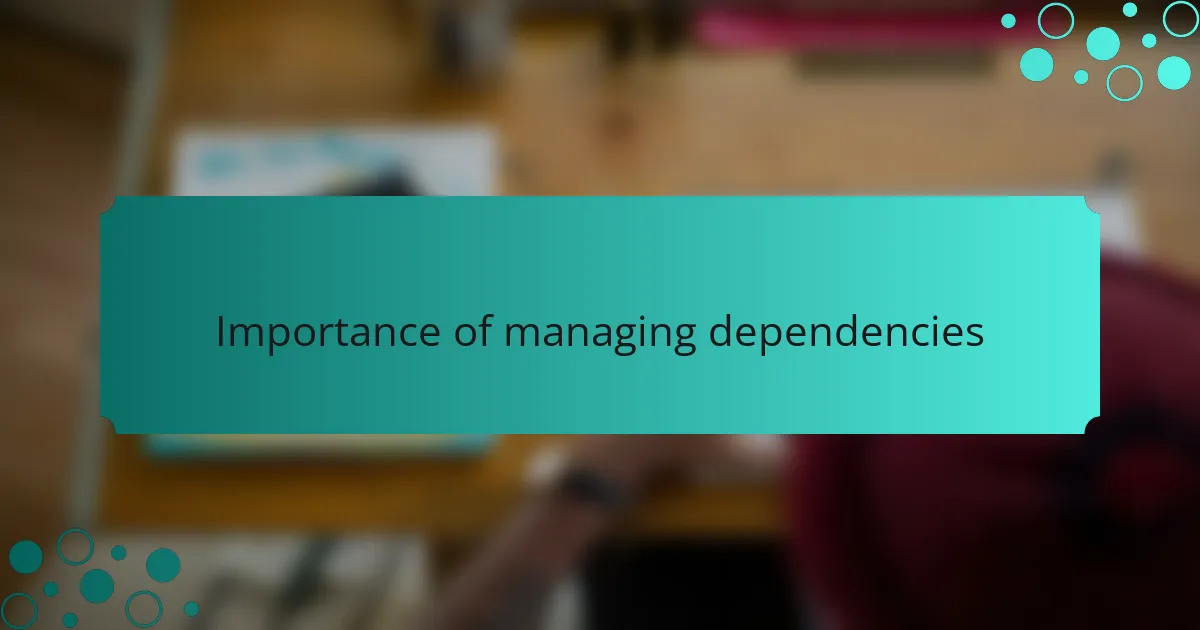
Importance of managing dependencies
Managing dependencies is crucial in Ruby on Rails development because it helps maintain the integrity and stability of your application. I remember a time when I overlooked updating a gem, which led to conflicts further down the line. That experience taught me that keeping a close eye on dependencies ensures smoother performance and protects my projects from unexpected issues.
Here are a few reasons why effective dependency management is so important:
- Stability: Ensures that your application runs consistently without sudden crashes or bugs.
- Security: Regular updates can patch vulnerabilities in libraries that could otherwise be exploited.
- Performance: Optimized dependencies can improve load times and overall application efficiency.
- Collaboration: Simplifies onboarding for new team members by providing a clear structure of dependencies.
- Simplicity: Helps avoid the infamous “dependency hell,” where conflicting versions lead to unnecessary complexities.
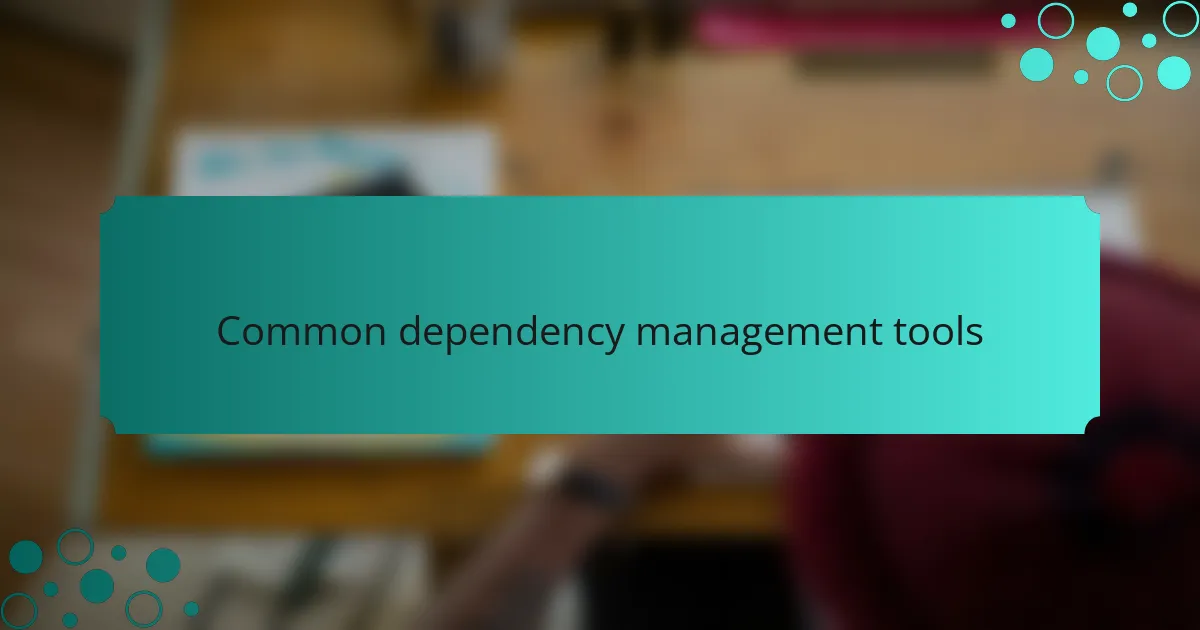
Common dependency management tools
Managing dependencies in Ruby on Rails often brings to mind the tool I regularly turn to: Bundler. I remember my early days of struggling with dependency conflicts, like trying to piece together a puzzle where the pieces just wouldn’t fit. Once I started using Bundler, it felt like someone handed me a roadmap. It not only helps to lock in specific gem versions but also provides a straightforward way to deal with updates. Isn’t it comforting to know that you can manage dependencies with just a few commands?
Another tool worth mentioning is RubyGems, which acts as a package manager for Ruby, making it easy to install and manage gem dependencies. I still find it impressive how RubyGems connects developers to a vast library of pre-built functionality. I recall discovering a gem that solved a persistent problem in one of my projects, and the instinctual thrill of realizing I wasn’t alone in solving this issue. The community support through RubyGems made me appreciate how collaborative and resourceful our development environment can be.
Lastly, don’t overlook tools like RVM (Ruby Version Manager) and rbenv, which help manage different Ruby environments seamlessly. I vividly remember running into version issues when my local setup didn’t match the production server. Switching to RVM transformed my workflow, allowing me to easily switch between Ruby versions without the usual headaches. Have you ever experienced the frustration of version mismatch? Using these tools not only solidifies my development process but also saves me valuable time that I can redirect toward building great features.
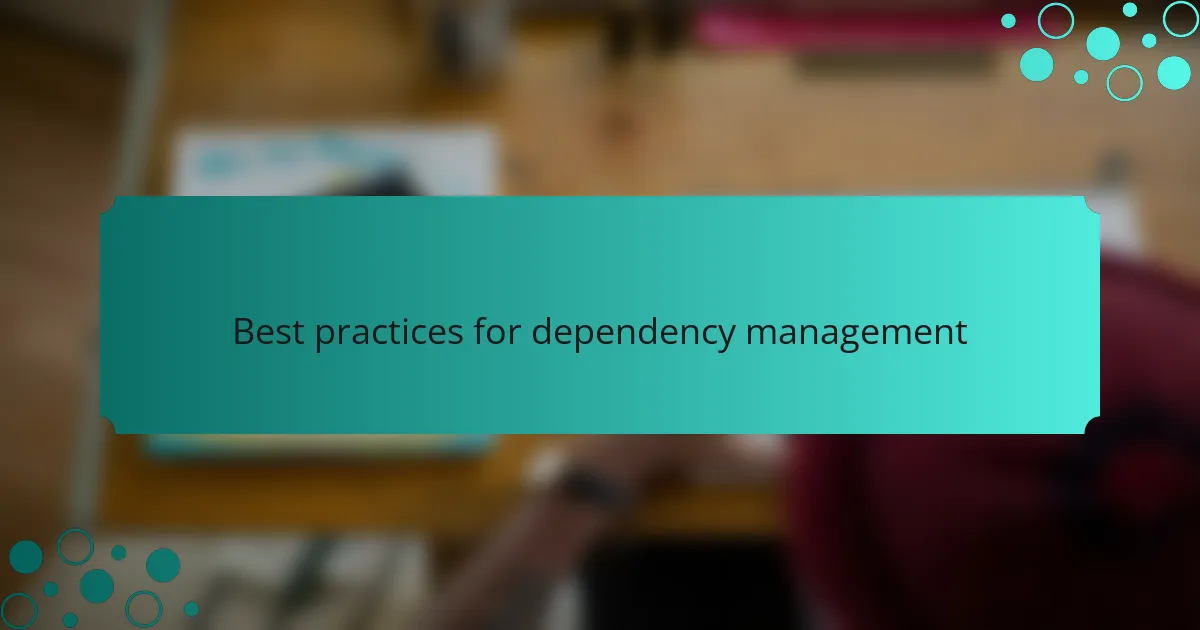
Best practices for dependency management
When it comes to best practices for managing dependencies in Ruby on Rails, I’ve learned that clarity is vital. One thing I always do is clearly define my gem versions in the Gemfile. I remember the headache of a last-minute feature request that coincided with a gem update that introduced breaking changes. Now, I take the time to specify the version using pessimistic versioning (like ‘~> 2.1’) to ensure compatibility while allowing for minor updates. It feels reassuring to know exactly what I’m working with.
Another practice I recommend is regularly auditing your dependencies. I typically run bundle outdated every few weeks to check for updates. There was a time when I neglected to do this, and a critical dependency went unaddressed for far too long, leaving me vulnerable to security risks. By keeping up with updates, I not only enhance performance but also fortify my application against potential threats. Have you ever thought about how many libraries run behind the scenes? It’s a good bet that you’re using gems that could benefit from the latest enhancements.
Lastly, don’t underestimate the power of comprehensive documentation. I often find myself reflecting on the moments when I updated a gem and had to dive back into the documentation to troubleshoot. It can be a time-consuming process, right? By documenting any unique integration steps or issues I encounter, I make it easier for my future self or any teammates who might jump in. This habit proves to be invaluable, turning a tedious task into a friendly guide through my project’s dependency landscape.
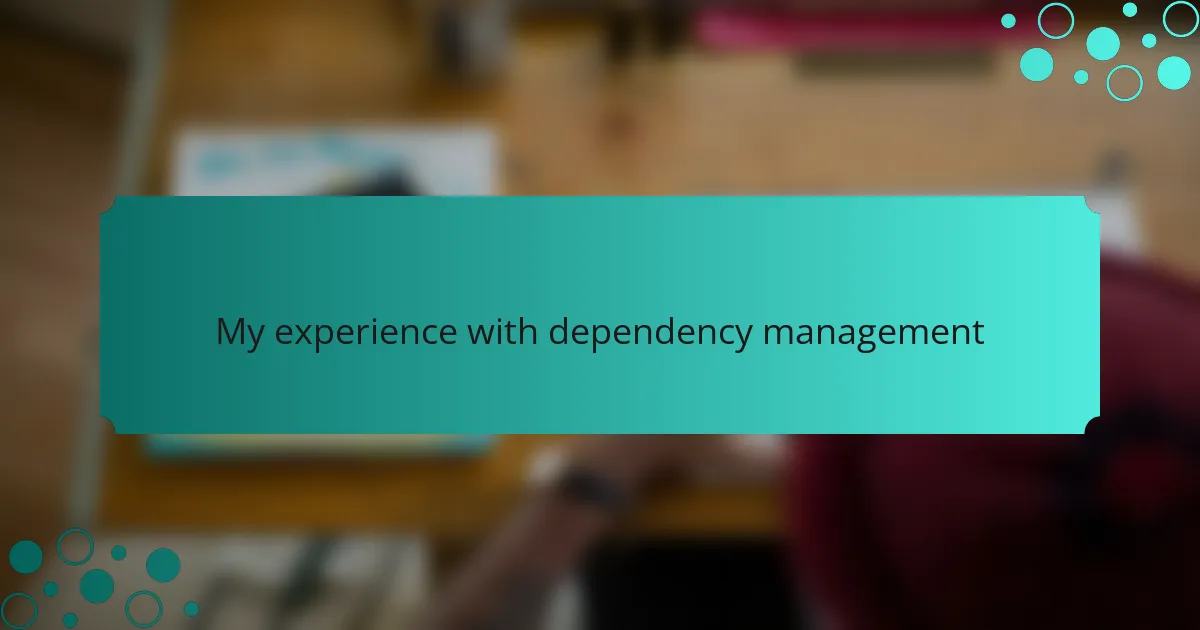
My experience with dependency management
My journey with managing dependencies in Ruby on Rails has been both challenging and rewarding. Early on, I faced the frustration of version conflicts, which often led to endless hours of debugging. I remember one project where a gem update caused my app to crash, and I realized how crucial careful version management is.
Over time, I learned the importance of using tools like Bundler, which streamlined the process significantly. I now enjoy a smoother experience with dependency management, allowing me to focus on building features rather than troubleshooting conflicts. It feels great to have control over my environment and ensure that everything runs seamlessly.
Here’s a comparison of my earlier struggles with dependencies versus my current approach:
| Aspect | Earlier Struggles | Current Approach |
|---|---|---|
| Version Conflicts | Frequent crashes | Managed with Bundler |
| Debugging Time | Hours lost | Minimal, focused on features |
| Control | Chaotic | Streamlined and effective |
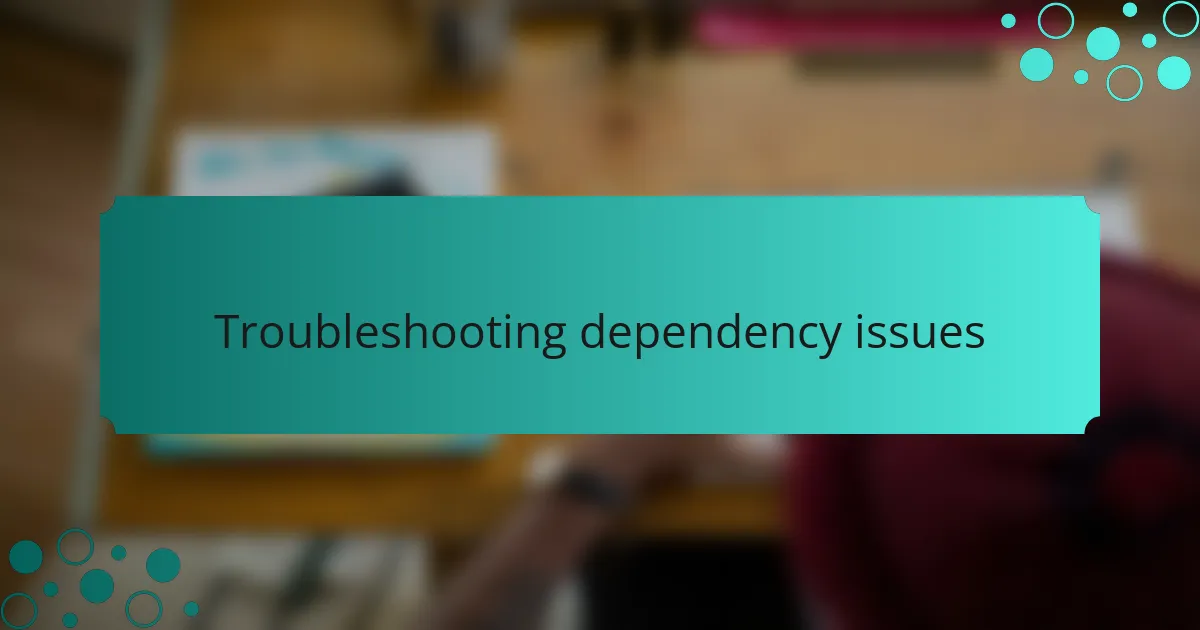
Troubleshooting dependency issues
Troubleshooting dependency issues can often feel like a maze, but it’s a puzzle I’ve learned to navigate over time. One frustrating instance stands out in my memory: I was using a gem that suddenly started causing unexpected errors after an update. It was clear that I needed to carefully comb through the changelog and documentation. Have you ever had that moment of panic when everything breaks, and you’re left wondering how to get back on track?
When I face conflicts, I often find that reverting to a previous stable version can be a lifesaver. There was a time when I updated several gems simultaneously, only to create a perfect storm of incompatibility. By using the Gemfile.lock to revert back, I managed to stabilize my application while isolating which gem was the culprit. Sometimes, taking a step back provides the clarity needed to resolve tricky dependency issues.
Additionally, I’ve developed a habit of running comprehensive tests whenever I make dependency changes. The peace of mind it brings is immense! I remember one project where I overlooked this step, leading to a nasty bug that surfaced only in production. Now, it’s a non-negotiable step in my workflow. Isn’t it reassuring to know that with a little diligence and testing, we can mitigate most potential headaches?
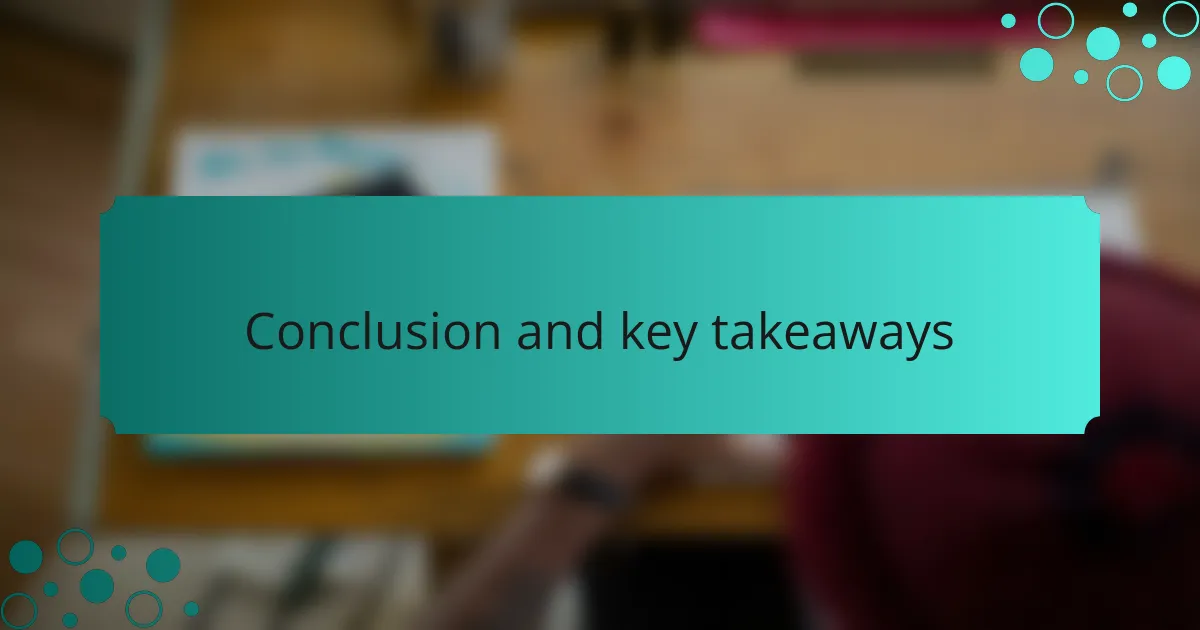
Conclusion and key takeaways
Managing dependencies in Ruby on Rails can feel overwhelming at times, but with the right approach, it becomes manageable and even rewarding. I’ve learned to appreciate the importance of keeping my gems updated and organized, as it not only streamlines my projects but also prevents potential headaches down the line. Ultimately, understanding how to effectively handle these dependencies empowers developers to build more robust applications.
One key takeaway for me has been the value of leveraging tools like Bundler for dependency management. It has not only simplified my workflow but also enhanced my experience as a developer. I’ve found that regular maintenance, like running bundle outdated and addressing vulnerabilities, ensures that my projects remain secure and efficient.
Here’s a quick comparison of some popular dependency management approaches in Ruby on Rails:
| Method | Pros |
|---|---|
| Bundler | Easy to use, automates gem installation |
| Manual Management | Complete control over versions |
| Gemfile.lock | Ensures consistency across environments |
